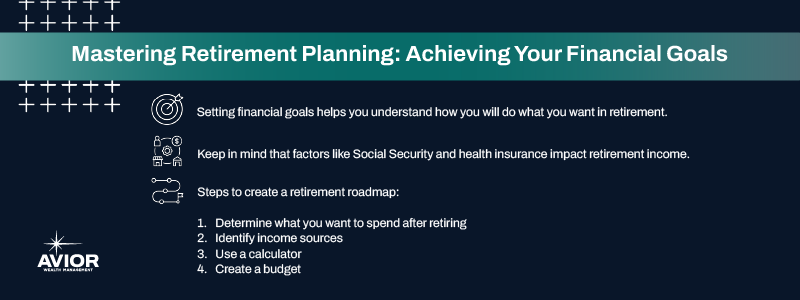Mastering Retirement Planning: Achieving Your Financial Goals
Even if retirement seems far away, you want to stay proactive. Learn how creating a strategy with the right guidance will help you reach your goals.

Retirement planning is one of the most important financial steps you’ll take in your life. With all of its moving parts, like Social Security, Medicare, and investments, it’s not easy to put all the pieces together. Creating the right retirement plan with the help of an expert can provide clarity and help you feel more confident in your future.
This guide covers how to set goals, navigate different retirement scenarios, craft a roadmap, and implement the proper financial strategies that will lead to a worry-free life in your golden years.
How to set your financial goals
Setting financial goals for retirement will help you achieve the life you want when you’re finished working. There may be goals you think you should have when it comes to retirement, but what’s more important is envisioning what you want retirement to look like. Starting with your current lifestyle may be a good starting point if you do not know exactly what you want in retirement.
When setting financial goals, consider your basic necessities first. Will you need more or less income than you have now? How will your daily expenses change? Will you own the same property, buy a different home, or have multiple mortgages?
In regard to separate goals outside of retirement planning, consider additional expenses like education for your children or family members. Do you want to pay for all those expenses or just a portion of tuition, for example? You might have a goal to cover all of your child’s college costs so they avoid student loans.
Whatever your retirement goals are, make sure they’re SMART:
- Specific
- Measurable
- Achievable
- Relevant
- Time-bound
Only then can you set goals that you can track, measure, and accomplish for a better retirement. Next, let’s discuss a few different scenarios for what the retirement landscape might look like.
Navigating different retirement scenarios
It’s wise to plan for your future but it can only be done to a certain extent. In reality, you won’t know exactly what will happen, including what the economy will look like, how your family will change, and whether your priorities will shift. This is why retirement planning takes continual effort and why you should stay proactive in planning on what to expect going forward.
One way to navigate the retirement landscape is to consider when you would want to retire. At 65, you’re eligible for Medicare. If you want to retire before 65, what is your plan for health insurance? COBRA or the Affordable Care Act can both be expensive alternatives unless you’re in a low-income bracket. So, health insurance is something to keep in mind. A health savings account (HSA) can be an effective choice to combat rising healthcare costs, now and in the future.
Another consideration is Social Security. If you’re closer to retirement age, you will probably see few changes to how the system works now. However, based on past alterations of Social Security, younger people will probably see the full retirement age pushed back because people are living longer today, which was the same reason it’s been changed in the past. Overall benefits might also be reduced but that would be for younger individuals since they would have more time to adjust their retirement planning.
It’s important to factor this in and understand that we don’t fully know what will happen to those benefits. Since lifespan longevity continues to rise, people in younger generations may need to budget for more retirement years.
Next, let’s dive into crafting the right retirement blueprint for success.
Steps to craft your retirement roadmap
You need to know the right steps to take to craft a retirement roadmap that will lead to success. As soon as you’re ready to make a plan, here’s a clear blueprint to follow:
1. Figure out how much you want to spend
The first step is to assess how much you want to spend in retirement. Clearly list out expenses you will likely have such as what it takes to run your house (this includes a mortgage if you have one, food, utilities, insurance, etc.), health insurance or an alternative, hobbies you may want to spend money on, and other possible expenses. What monthly spending stipend will allow you to reach the goals you came up with above?
2. Identify all of your income sources
Now it’s time to figure out the sources of your income and exactly how much you’ll get from each one. These will include Social Security, defined benefit plans (pensions), defined contribution plans (employer-sponsored plans), property income, including rental income, home equity, or a reverse mortgage, and more. Make sure you understand the tax consequences of each of these options and what you would actually receive net so that you are not overestimating your income received.
3. Use a calculator
An online retirement calculator can be a very helpful tool, especially if you have a defined contribution plan so you know exactly what you’ll be contributing each year until you retire. These calculators ask for several factors, including your age now, age of retirement, income increases or decreases, and more.
4. Create a budget
Once you’ve identified your expected income sources and your anticipated expenses, you can create a budget based on your goals. Outline what you’ll be contributing each month. As a general rule, a good goal is saving at least 15% of your income each month.
The last step is to figure out your investment strategy, which deserves more focus in the next section.
Determining your investment strategy
Your retirement investment strategy will look a little different based on your age, income, when you want to retire, and other factors. For example, if you’re still decades away from retirement in your 20s or 30s, you may take a more aggressive investment strategy since you have time for your money to recover from a market downturn and come back up. When you get closer to retirement, you want to be more conservative so that when money is withdrawn from your accounts, investments with low volatility can be used and they’ll incur less losses versus riskier options that may have more losses if the market is down. That way, higher loss investments can be kept so they can recover.
It’s also important to have a mix of investment types to protect your assets. Always talk to a financial advisor when you’re not sure how to create a diversified portfolio or balance risk effectively.
Many retirement accounts give you tax benefits. For traditional tax-deferred accounts like 401(k)s and IRAs, you contribute pre-tax dollars now and pay taxes on the income in retirement. Roth accounts, on the other hand, require that you pay taxes on contributions now which allows you to invest your Roth contributions and not pay taxes on the earnings you have throughout your working career and beyond.
In general, the younger you are, the more it makes sense to put more money into a Roth IRA because you will have time for your investments to grow tax-free and more than likely it will be the time in your life when you will be paying the least amount in taxes. Now, there are income limits to putting money in a Roth IRA to be aware of. For pretax retirement accounts, these are primarily used for higher-income earners or those that do not have a Roth option or have maxed out their contributions into a Roth account. It’s recommended to use a pretax account before putting money into a taxable account.
Your best bet: figure out when you think you’ll be in the highest tax bracket, now or in retirement. If now, you want to defer that tax obligation; if you’ll make more in retirement, you may want to take care of taxes now.
These decisions will vary for everyone but they’re significant. That’s why you need the help of an experienced financial advisor who understands the best way forward for your unique situation.
Why prioritize retirement planning?
Retirement planning is a key component of any successful financial strategy. When you stay proactive and prepared, you’ll be financially secure when you retire and will get to lead the life you envision. Set goals, create a budget, and work with a financial advisor for guidance.
Mastering retirement planning is the foundation for realizing your desired financial future.
Contact the experts at Avior to schedule a consultation when you need retirement planning support.
Byline: Kyle Spitzenberger has been a financial planner with Avior Wealth Management since June of 2022. He passed the CFP exam in 2022, worked on roughly 100 financial plans in 2023, and will complete his full CFP certification in 2024. Kyle gains expertise through a holistic planning approach and enjoys helping people get the most out of their retirement.
Disclaimer: Nothing contained herein should be construed as legal or tax advice. Avior and our Advisors will work with your attorney and/or tax professional to assist with your legal and tax strategies. Please consult your attorney or tax professional with specific legal and/or tax questions.
No Comments
Sorry, the comment form is closed at this time.




